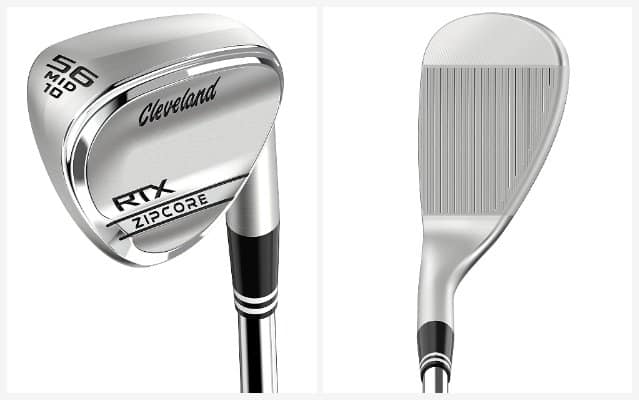So, you’ve decided to buy a gap wedge.
One of the biggest decisions you’ll need to make – aside from which brand to purchase – is whether your shiny new gap wedge will come with 50 or 52 degrees of loft.
What are the differences? And which one should you choose? The answer: it depends on what loft your pitching wedge is.
If you have a pitching wedge with 46 degrees of loft, you’re better to use a 50 degree gap wedge. If your pitching wedge has 48 degrees of loft, then a 52 degree wedge will be a better choice. This will ensure you have the correct gapping between your wedges.
‘Gapping’ describes the carry distances between each of your clubs and you want to make sure they are as even as possible for the best results.
For instance, you don’t want your 9-iron to fly 142 yards (130 metres), your pitching wedge 125 yards (115 metres), only for your gap wedge to fly 98 yards (90 metres) when it should actually be 109 yards (100 metres) if maintaining consistent gapping.
As a general rule, club lofts tend to increase in four-degree increments, so whatever loft your pitching wedge has (either 46 or 48 degrees, which are the average figures), simply add four degrees and that will tell you which gap wedge to buy (either 50 or 52 degrees).
If you’re unsure what loft your pitching wedge has, take it down to your local club fitter and they’ll easily be able to tell you.
Table of contents
Is it better to use a 50 or 52 degree wedge?
Whether to use a 50 or 52 degree wedge will be determined by the loft of your pitching wedge. If your pitching wedge has 46 degrees of loft, then it’s best to use a 50 degree gap wedge. If your pitching wedge has 48 degrees of loft, then you should use a 52 degree wedge.
Of course, this is only a guide and not every pitching wedge will be either 46 or 48 degrees in loft – some people have their clubs bent to stronger lofts, with their pitching wedge more closely resembling a 9-iron.
What matters most is that whichever gap wedge you choose – either 50 or 52 degrees – it has to replicate as close as possible the gapping between the rest of your clubs.
Personally, I’ve chopped and changed between using a 50 and 52 degree wedge after going from one set of irons to another, as the carry distances for my old clubs were different when compared to my new ones.
One is not better than the other – what’s important is that you select a gap wedge that matches the gapping of your pitching wedge and irons to ensure you hit your intended yardages out on the course.
What is a 50 degree wedge used for?
A 50 degree wedge is used to fill the ‘gap’ between your pitching wedge and sand wedge. This is why it’s commonly known as a gap wedge. Usually, golfers will add a 50 degree wedge to their bag if their pitching wedge has 46 degrees of loft and sand wedge has 54 degrees of loft.
The 50 degree set-up is the most common you’ll find for gap wedges and can be used anywhere inside 100 yards – either for a full swing, a pitch shot, or a chip shot.
When making an approach shot with a full swing, a 50 degree wedge can really allow you stuff the ball in close to the pin and impart plenty of backspin on the ball – much more so than a standard pitching wedge.
Lower handicap players, especially those with excellent touch around the greens, will often use their 50 degree wedge for bump and runs as they can exert plenty of backspin on the ball and stop it dead on their intended spot.
For higher handicap players, the thought of using a 50 degree wedge for chipping may be a little daunting as the sharper leading edge (when compared to a 7 or 8-iron) has a greater chance of digging into the turf and causing a fat strike.
These players may benefit from using a chipper like the Square Strike Wedge if they really have the chipping yips (we’ve written a full review of our favourite chippers here).
What is a 52 degree wedge used for?
A 52 degree wedge is used to fill the ‘gap’ between your pitching wedge and sand wedge. This is why it’s commonly known as a gap wedge. Usually, golfers will add a 52 degree wedge to their bag if their pitching wedge has 48 degrees of loft and sand wedge has 56 degrees of loft.
It’s usually less common to see players with a 52 degree wedge in their bag, but it’s not unheard of.
This is actually the set-up that I’m gaming at the moment as it perfectly fits the gap between my Srixon ZX7 pitching wedge and my Cleveland RTX ZipCore 56 degree sand wedge.
A 52 degree wedge can be used for the exact same purposes as a 50 degree wedge – attacking a pin inside 100 yards, playing pitch shots inside 30 yards, or for bump and run chip shots around the green.
If you can get really good at using your gap wedge, you’ll notice your scores drop dramatically and find yourself regularly breaking 90 or better.
Below are some more articles you might find useful for improving your short game:
- Stop It Dead: How To Put Backspin On Your Wedges In Golf
- 4 Best Golf Chipping Techniques (And How To Master Them)
- How To Chip Consistently In Golf (Decide To Go High Or Low)
- Chipping vs Pitching In Golf: The Key Differences Explained
How far should you hit a 50 degree wedge?
The average male golfer will hit their 50 degree wedge anywhere between 90-110 yards (82-100 metres), while female players will range between 65-85 yards (59-77 metres). Professional male players average around 124 yards (113 metres) with their gap wedge, and female players 95 yards (86 metres).
This data for professional players is calculated by assessing TrackMan carry distances for both elite men and women players, determining the gapping and then subtracting it from the pitching wedge distance numbers.
Obviously, this is not an exact science and there can be as much as 10 yards or more of variance between carry distances with a 50 degree wedge depending on whether you’re taking a full swing, three-quarter swing or half swing.
How far should you hit a 52 degree wedge?
Generally, a 52 degree wedge will travel around five yards less than a 50 degree wedge. This is anywhere between 85-105 yards (77-96 metres) for the average male golfer, and 60-80 yards (54-73 metres) for the average female golfer. Male pros will hit their 52 degree wedge around 120 yards (109 metres), and female players 90 yards (82 metres).
There isn’t a huge gap in distance between a 52 and 50 degree wedge, but it is enough to distinguish between the two clubs – and it is important you select the correct one to match your gapping.
The last thing you want is to use a 52 degree wedge only to come up five yards short of your target every time you hit an approach shot into a green.
Determine your gapping first and then select the wedge that best fills it – whether it be one with 52 or 50 degrees of loft.

What is the best 50 or 52 degree wedge to use?
Personally, my favourite gap wedge is the Cleveland RTX ZipCore. It is available in both 50 and 52 degrees and also 54, 56, 58 and 60 degrees, meaning you can get matching sand and lob wedges to suit your required gapping.
I’ve been gaming the Cleveland RTX ZipCore wedges (pictured above) for a while now and find them to be fantastic clubs, offering enough forgiveness for mid-to-low handicap players yet still imparting plenty of spin on the ball when needed for excellent control.
You’ll have no problem spinning your approach shots back to the hole with these wedges, or stopping a chip shot dead only a few feet from the pin.
However, if you’d rather explore your options, we’ve written a comprehensive review of the Best Wedges on the market at the moment – ranking our favourites from each manufacturer, but also grading them based on spin, forgiveness, bunker ability, overall performance and value.
I definitely recommend you give it a read.
Final message
Choosing whether to game a 50 or 52 degree wedge ultimately comes down to how much loft your pitching wedge has, how far you hit it, and what gap in distance it will leave between it and your sand wedge.
Both clubs are equally as easy to hit and perform just as well as the other – the only difference being the 52 degree wedge, naturally, travels slightly shorter through the air.
Determine your gapping needs, and it quickly become clear whether you need to add a 50 or 52 degree wedge to your bag.


